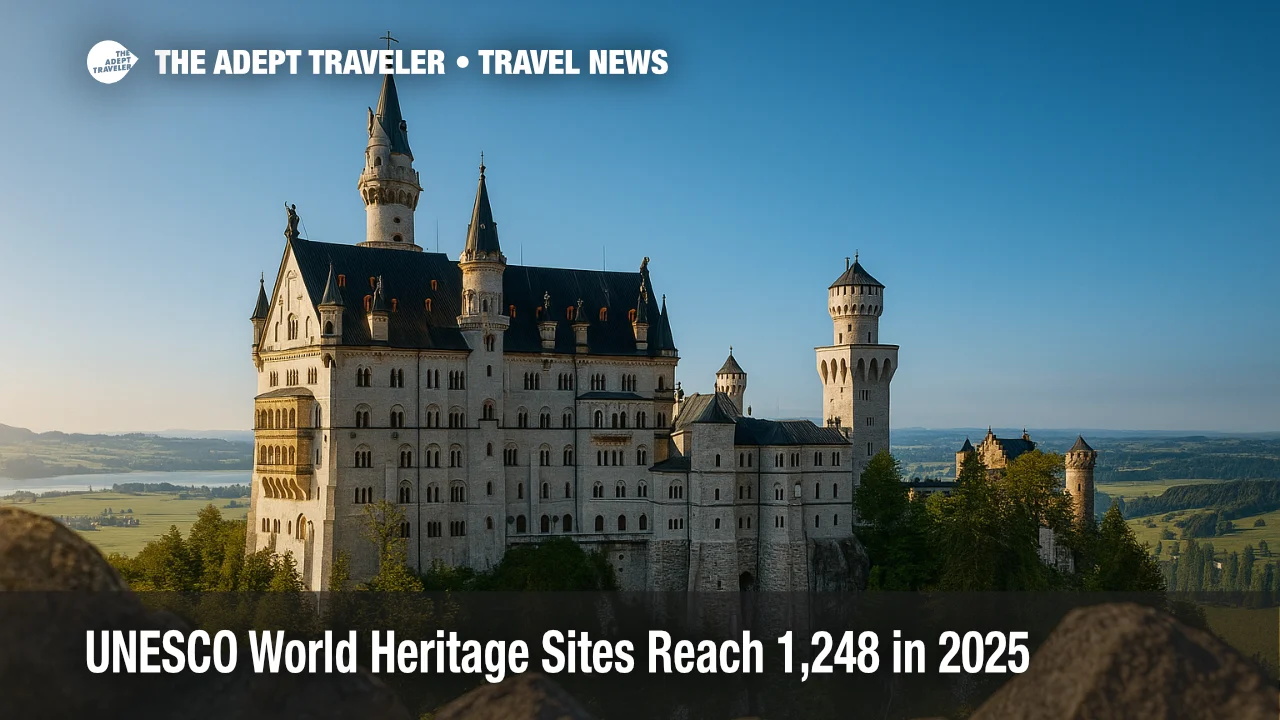UNESCO World Heritage Sites Reach 1,248 After 2025 Additions

UNESCO has pushed the World Heritage List to a record 1,248 locations after approving 26 fresh inscriptions during its July 2025 meeting. The newly crowned treasures-ranging from Germany's story-book palaces to Malawi's sacred Mount Mulanje-highlight humanity's cultural ingenuity and the planet's natural splendor. The expanded roster, now spanning more than 170 countries, elevates global conservation standards while offering travelers an ever-growing bucket list of once-in-a-lifetime experiences. Securing a coveted place on the list brings international oversight, funding access, and heightened visitor interest, underscoring UNESCO's pivotal preservation role.
Key Points
- List now holds 1,248 UNESCO World Heritage Sites.
- Twenty-six properties inscribed at the 47th session.
- Cultural, natural, and mixed sites received recognition.
- Why it matters: inscription unlocks funding, publicity, and stricter safeguards.
- Germany's King Ludwig II palaces headline 2025's additions.
Snapshot
The UNESCO World Heritage List identifies places of "Outstanding Universal Value" that belong to all humankind. Each site falls into one of three buckets-cultural, natural, or mixed-based on defined criteria such as architecture, biodiversity, or landscape harmony. Once inscribed, a property must maintain preservation plans that balance local needs with global stewardship. Since the first twelve listings in 1978, the roster has expanded annually, fueling travel dreams and conservation budgets alike. Inscription can lift tourism arrivals by double-digit percentages, prompting destination managers to implement visitor-cap limits, timed-entry systems, and community-led guides to curb overuse.
Background
UNESCO, founded in 1945 to promote peace through culture, education, and science, launched the World Heritage Convention in 1972. The framework obliged signatory nations to inventory and protect heritage within their borders while permitting global oversight. Early icons such as Yellowstone National Park and Egypt's Abu Simbel temples set a dual precedent: safeguarding both natural wonders and human achievement. Over five decades, the list reflected shifting priorities-from rescuing war-damaged monuments in the 1990s to spotlighting Indigenous management of cultural landscapes today. With climate change accelerating risks, UNESCO now ties inscription to adaptation strategies that fund shoreline defenses, wildfire buffers, and sustainable visitor flows.
Latest Developments
UNESCO's 47th session, held this July in New Delhi, endorsed twenty-six nominations after rigorous field evaluations. The decision brings tangible benefits, including emergency-response funds and capacity-building workshops for local custodians. Highlights of the 2025 class include:
Cultural Marvels
- The Palaces of King Ludwig II of Bavaria - Neuschwanstein, Linderhof, Schachen, and Herrenchiemsee gained collective status for their eclectic revivalist architecture and pioneering engineering. Neuschwanstein's fairy-tale silhouette famously inspired Walt Disney's Sleeping Beauty Castle, drawing 1.7 million annual visitors even before inscription.
- Megaliths of Carnac and the Shores of Morbihan, France - More than 3,000 standing stones, some erected as early as 4500 BC, illustrate prehistoric ritual sophistication.
- Minoan Palatial Centres, Greece - Knossos, Phaistos, and Malia exemplify Bronze-Age urban planning and far-reaching trade networks.
Natural Wonders
- Mount Mulanje Cultural Landscape, Malawi - Towering granite cliffs shelter endemic cedar forests and hold spiritual meaning for local Chewa communities.
- Cavernas do Peruaçu National Park, Brazil - A labyrinth of limestone caves houses rock art dating back 12,000 years and rare cave-dwelling fauna.
- Møns Klint, Denmark - White-chalk sea cliffs reveal 70 million years of marine fossils and migratory bird habitats.
Mixed & Cultural Landscapes
- Murujuga Cultural Landscape, Australia - Home to up to a million petroglyphs, the Burrup Peninsula merges ecological value with one of the world's richest rock-art concentrations.
- Wixárika Route to Wirikuta, Mexico - Sacred pilgrimage trail spans deserts and mountains, intertwining spiritual rites with fragile ecosystems.
- Cambodian Memorial Sites - Former Khmer Rouge detention centers now serve as places of reflection, advancing reconciliation and genocide education.
A full rundown of 2025's newcomers can be found in Adept Traveler's focused briefing on Carnac, Ludwig castles, and other headline sites. Read the detailed list here.
Analysis
For travelers, the enlarged roster represents fresh itinerary potential-but also a reminder to tread lightly. Newly anointed destinations often witness visitation spikes of 10 to 30 percent within two years, pressuring fragile ecosystems and small communities. Responsible operators increasingly schedule shoulder-season departures, impose group-size caps, and channel a portion of tour fees toward conservation. Tech tools such as real-time crowd dashboards and geofenced alerts now help stewards divert footfall from overburdened zones. Meanwhile, tighter rules can affect access: Germany's Bavarian palaces will pilot timed-entry tickets, and Malawi's forest rangers plan to restrict summit camping on Mount Mulanje. Travelers should book early, verify local regulations, and favor certified guides who support UNESCO management plans. By aligning curiosity with care, visitors ensure that inscription translates into long-term preservation, not degradation.
Final Thoughts
With 1,248 UNESCO World Heritage Sites now dotting the globe, even the most ambitious travelers will never exhaust the list. Yet each addition underscores a shared obligation: protect irreplaceable wonders so future generations can stand in the same awe. Approach every newly inscribed treasure with respect, flexibility, and an awareness of community guidelines. Your mindful footsteps today will help sustain UNESCO World Heritage Sites tomorrow.
